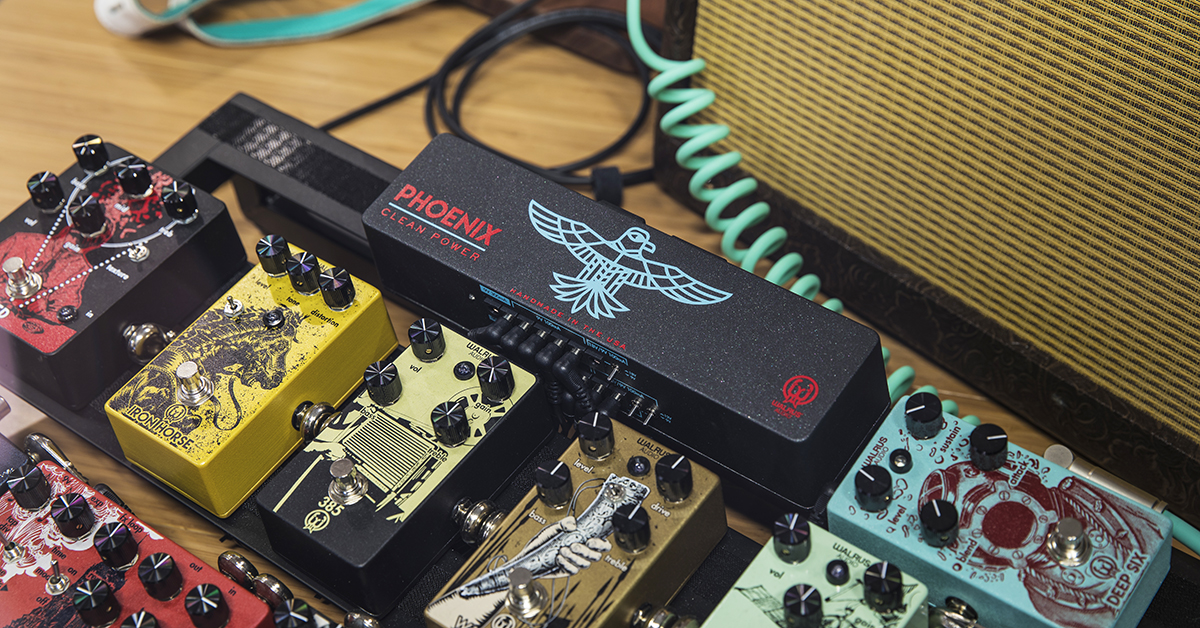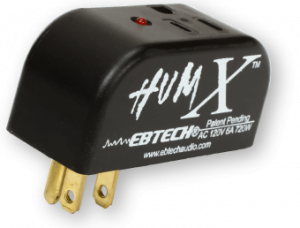Guitar Pedal Power Demystified

Guitar pedal power parameters
If you are setting up a pedal for the first time or troubleshooting your pedalboard, make sure your pedals are powered correctly — not doing so can damage your gear! Power supplies can be incompatible, produce extra buzz and noise, and go bad from wear and tear. Whether you’re using a battery, wall-wart power supply, or pedalboard supply with isolated outputs, make sure the power supply satisfies all three requirements: voltage, polarity, and amperage.
Voltage (9v, 12v, 18v, 24v)
Tip: Use a voltage doubler to convert a 9-volt or 12-volt power output for use with 18-volt or 24-volt guitar pedals. If your power supply has 18 volts, you can use this converter to bring it down to 9 volts.
Although 9-volt power is the most common, there are tons of pedals that require more. The important thing to remember is to only use the exact voltage specified by the pedal. Some pedals (overdrives in particular) are built to accept 9 volts or 18 volts. Changing from 9 to 18 volts can give you a little more headroom and may also change the tone, but this is by design. If your pedal does not specifically mention that it can operate on a different voltage, then make sure the voltage on your power supply matches what’s on the pedal — or you could blow it up!
Examples of guitar pedal voltage requirements.
Positive (+) or Negative (-) polarity
The next parameter is polarity. Most pedals require a power supply with negative (-) polarity, and they should only be powered by a power supply with a matching (negative) polarity. Using a positive (+) power supply with a negative (-) pedal could prevent it from powering on (if you’re lucky) or (if you’re unlucky) permanently damage the pedal.
Most pedals and power supplies have a diagram showing the polarity. If the diagram on your pedal matches the power supply, you’re good. If not, you’ll need a polarity adapter to reverse it.
Examples of positive and negative guitar pedal polarity.
Amperage (10mA, 500mA, 1.7A)
The last pedal power parameter is amperage (rate of the electrical current.) Your power supply must meet or exceed the pedal’s amperage requirement, usually measured in milliamps (mA). Not doing so could cause irregular performance or even damage!
A milliamp meter is useful to view the exact amperage draw of a pedal. This can prove important when configuring and assembling your pedalboard. If you are daisy-chaining pedals, the amperage ratings of each pedal are added together for one total amperage requirement. Failure to meet the total amperage requirement will underpower your pedals and possibly damage them.
Examples of guitar pedal amperage requirements.
Preventing hum, noise, and ground loops
In the battle for good pedal power, meeting the power requirements for your pedals is only half the battle. The other half is to provide a clean power source. Without clean power, you’re likely to experience ground loops or interference –and always at least opportune times.
Hum caused by ground loops
If you hear humming, it’s likely caused by a ground loop. Ground loops occur when a circuit has more than one path to ground. When engaged, the ground connection is added or removed; thus, the ground loop no longer has more than one path to ground, and the “hum sound” should disappear. Long story short, this behavior will typically happen when you least expect it but is usually fixable with a bit of trial and error. If your pedal has a ground button or switch, try that first.
If your device does not have a ground switch, consider testing it by using a ground lift adapter (no ground plug). If the hum goes away, then you found the offending device. A ground lift adapter is an excellent way to find the problem, but they’re not great for long-term use. Ebtech’s Hum X is a safer solution for removing and preventing ground loops.
Get rid of a ground loop in your system with the HumX!
Isolated Power Supplies for Pedal Boards
You can fix some pedal power problems by switching to an isolated power supply. When pedals share the same power output, they can introduce unwanted noise and interference to the signal. This phenomenon is most common in daisy-chained pedals. Supplies like the Truetone 1 Spot work great for sufficiently powering individual pedals (or multiple with an adapter). While most of the time, you will not have an issue with daisy-chaining the power from one pedal to the next, some pedals may not function as designed if they receive power from a shared power supply. Some combinations of pedals can even introduce extra noise.
Pedalboard powered by an isolated power supply.
If this issue is present on your pedalboard, an isolated power supply might be the best solution. The outputs on an isolated power supply operate independently from one another, helping to prevent unwanted interactions between pedals. In addition to providing reliable power for your pedals, they also frequently provide outputs for pedals rated at different amperages and voltages. This effectively prevents ground loops, interference, and other issues caused by having pedals daisy-chained together.
Remove Noise with Power Conditioners
If you show up to a gig and you’re suddenly getting a nasty hiss or buzz, you may be dealing with dirty power. Dirty power is any power source that, in addition to the power, also contains unwanted noise from other devices or components on the same circuit. The usual suspects are:
- Old wiring (knob & tube).
- Dimmable lights.
- The motors in refrigerators or other large appliances.
The best solution is prevention, and the best prevention is a power conditioner.
A power conditioner’s job is to provide clean power for your rig. Depending on the model, power conditioners can prevent electromagnetic and radio interference noise and provide surge protection, voltage regulation, and digital filtering. If you’re a musician on the go, a quality power conditioner will protect your gear and give you the peace of mind you need to play your best.
Use a power conditioner to run your rig on clean power!
Guitar pedal power tips & FAQ
Power conditioners, isolated power supplies, and a knowing each pedal’s power requirements are the building blocks of a reliable pedalboard. Whether you’re setting up you board for the first time or at a show ready to play, the tips below will keep you pointed in the right direction.
My pedal seems noisier than it should be.
Noisy pedals share similar symptom(s) but not necessarily the same cause(s). Many different sources can plague your signal with noise. Fluorescent lights, old computer monitors, and dirty AC lines are some of the more common things that can cause interference.
Also, keep your pedals a healthy distance from your amp. The electromagnetic field produced by your amplifier can interact with your pickups and other nearby devices to add noise to your signal. Keep a few feet of separation between your pedalboard and amp.
My guitar pedal makes a pop noise when I switch it on.
This is normal! This happens because the capacitors in the circuit leak a little bit of DC while the pedal is in the bypassed state. When you engage the pedal, the capacitors charge back up to the proper operating voltage, translating into a small pop in the audio signal. The pop may be louder or quieter depending on the capacitor’s quality or the nature of the effect (i.e., high-gain pedals may have a louder pop).
Do I need to use a power supply from the same manufacturer as my pedal?
Many manufacturers advise only to use the included power supply (or one made by them) with your pedal. This is to help ensure that an incompatible supply does not damage the pedal. For the most part, any compatible power supply will work with any pedal. A “compatible” power supply has a plug that fits and meets the three pedal power parameters (Polarity, Voltage, & Amperage). For pedals with unique power requirements, an alternative power supply is not recommended and, sometimes, not even an option. Consult your user manual to be sure.
Should I use a daisy-chained power supply or an isolated power supply?
Some power supplies, adapters, and even pedals allow you to chain the power from one pedal or connector to another. For many pedalboards, this is an efficient and convenient solution. When you daisy-chain pedals with the same power supply, you may run into performance loss. Pedals may not work as usual when engaged, and additional noise may be present in your signal — some pedals may not power on at all.
But how do you fix this problem? Isolated power supplies are the best solution. Experimenting with your pedalboard is the key to finding the ideal setup.
Should I use batteries to power my guitar pedal?
Make sure your pedal is tested with a fresh set of batteries. If you use batteries with your pedal, choose a high-quality, name-brand option. Many “budget-friendly” brands do not provide adequate voltage or last as long as some of the more recognizable brands. When you are done jamming, make sure to disconnect the 1/4″ cable from your pedal to avoid draining the battery. Also, watch out for battery acid and be sure to dispose of dead batteries properly.
I can’t figure out what’s causing the problem!
When you’ve tried all other options and still can’t find the problem, don’t worry! You can always start from scratch. Checking everything one piece at a time is sometimes the only way to find the cause. Test each cable, power supply, and pedal one by one. This will ensure that every link in the chain is working correctly and shed light on any incompatible power supplies or bad cables. Once done, reassemble your pedalboard. Consider testing as you go, and leave no stone unturned.
Related Articles
When you need help, Sweetwater has the answers!
Our knowledge base contains over 28,000 expertly written tech articles that will give you answers and help you get the most out of your gear. Our pro musicians and gear experts update content daily to keep you informed and on your way. Best of all, it’s totally FREE, and it’s just another reason that you get more at Sweetwater.com.





